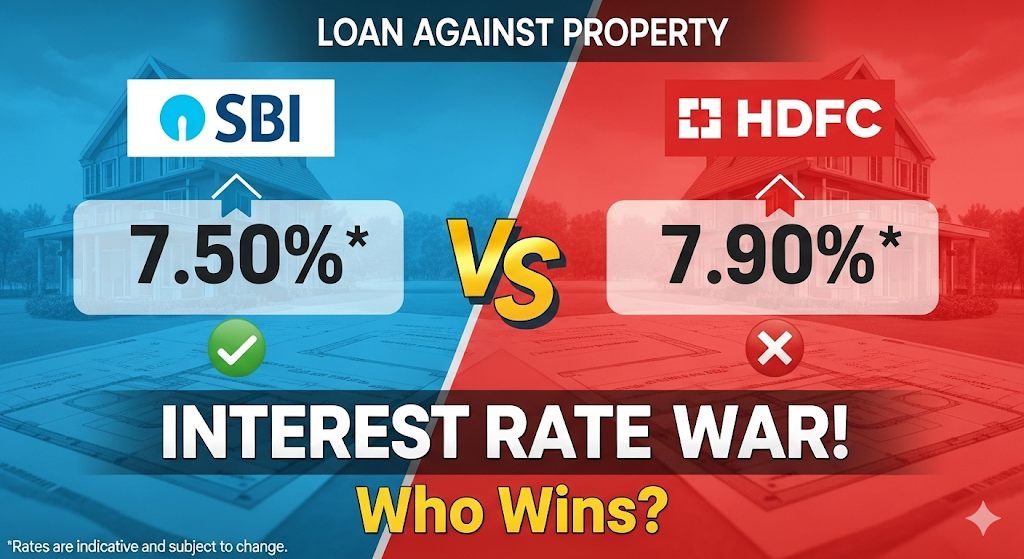Are you sitting on a valuable asset like a home or commercial property, wondering how to turn it into cash for your business or personal needs? A Loan Against Property (LAP) could be your answer, offering a cost-effective way to access funds without selling your asset.
But with so many lenders out there, how do you choose the right one? Today, I’m comparing two of India’s top banks—SBI and HDFC—for their Loan Against Property interest rates, eligibility, and features in 2025. Let’s break it down to help you make an informed decision.
Why Choose a Loan Against Property?
A Loan Against Property allows you to pledge your residential or commercial property to secure funds for personal or business needs, such as business expansion, education, or debt consolidation.
Unlike personal loans, LAPs come with lower interest rates because they’re secured, making them a smart choice for big-ticket financing. Both State Bank of India (SBI) and HDFC Bank are trusted names in this space, offering competitive rates and flexible terms. But which one suits you better? Let’s explore.
SBI Loan Against Property: Key Features
SBI, India’s largest public sector bank, is known for its transparency and competitive offerings. Its Loan Against Property is designed to meet diverse financial needs with attractive rates and borrower-friendly terms. Here’s what you need to know:
- Interest Rates: SBI offers LAP interest rates ranging from 9.20% to 10.50% per annum, depending on factors like your credit score, income stability, and property type. These rates are among the most competitive in the market, especially for salaried individuals.
- Loan Amount: You can borrow up to 65-70% of your property’s market value, with loan amounts tailored to your repayment capacity.
- Repayment Tenure: SBI provides flexible tenures of up to 15 years, keeping EMIs manageable.
- Processing Fees: A modest 1% of the loan amount (up to ₹50,000 plus taxes) ensures affordability.
- Eligibility: Open to Indian residents aged 18 to 70, including salaried, self-employed, and non-resident Indians (NRIs) with properties in India.
- Transparency: SBI is upfront about all charges, with no hidden fees, and offers tools like the SBI Loan Against Property EMI Calculator to plan your repayments.
SBI’s low processing fees and no prepayment penalties make it a strong contender for those looking to minimize costs over the loan term.
HDFC Bank Loan Against Property: What’s on Offer?
HDFC Bank, a leading private sector bank, is renowned for its customer-centric approach and innovative loan products.
Its Loan Against Property is tailored for both salaried and self-employed individuals, with unique features like an overdraft facility. Here’s a closer look:
- Interest Rates: HDFC’s floating rates range from 9.05% to 13.50% p.a., while fixed rates are between 11.80% and 13.30% p.a. Rates vary based on your credit profile, loan amount, and property type.
- Loan Amount: You can borrow up to 65% of the property’s market value, with higher limits for residential properties compared to commercial ones.
- Repayment Tenure: HDFC offers tenures of up to 15 years for LAP and up to 9 years for loans against rent receivables.
- Processing Fees: HDFC charges a lower processing fee of 0.50% of the loan amount, making it more cost-effective than SBI in this aspect.
- Overdraft Facility: A standout feature, HDFC’s dropline overdraft allows you to pay interest only on the amount utilized, ideal for self-employed individuals with fluctuating cash flows.
- Eligibility: Available to salaried and self-employed professionals (e.g., doctors, lawyers) and non-professionals (e.g., traders, contractors) with a minimum monthly income of ₹12,000.
HDFC’s quick processing and doorstep service make it a convenient choice for those prioritizing ease and flexibility.
SBI vs HDFC: A Side-by-Side Comparison
To help you decide, here’s a concise comparison of the key specifications for SBI and HDFC Loan Against Property in 2025:
| Feature | SBI | HDFC Bank |
|---|---|---|
| Interest Rates | 9.20% – 10.50% p.a. | 9.05% – 13.50% p.a. (floating); 11.80% – 13.30% p.a. (fixed) |
| Loan Amount | Up to 65-70% of property value | Up to 65% of property value |
| Repayment Tenure | Up to 15 years | Up to 15 years (9 years for rent receivables) |
| Processing Fees | 1% of loan amount (max ₹50,000) | 0.50% of loan amount |
| Prepayment Penalty | None | None for floating rate loans |
| Special Features | EMI Calculator, transparency | Overdraft facility, doorstep service |
Which Bank Should You Choose?
Choosing between SBI and HDFC depends on your financial needs and priorities:
- Opt for SBI if: You want the lowest possible interest rates (starting at 9.20%) and value transparency and no prepayment penalties. SBI is ideal for salaried individuals or those with stable incomes who want predictable EMIs. Its nationwide presence and EMI calculator make it a reliable choice for planning your finances.
- Choose HDFC if: You’re self-employed or need flexibility with repayments. The overdraft facility is a game-changer for businesses with variable cash flows, and the lower processing fees (0.50%) are a bonus. HDFC’s quick processing and customer service are perfect for those who value convenience.
Your credit score plays a pivotal role in securing lower rates with either bank. A score above 750 can unlock better terms, so check your CIBIL score before applying. Additionally, consider the property type—self-occupied residential properties often attract lower rates than commercial or rented ones.
Tips to Maximize Your Loan Against Property Benefits
- Compare Rates: Use online EMI calculators from BankBazaar to estimate your monthly repayments and total interest costs.
- Maintain a Strong Credit Score: Pay EMIs and credit card bills on time to boost your score, as lenders offer better rates to those with scores above 750.
- Add a Co-Applicant: Including a female co-applicant or a family member with stable income can lower rates and increase eligibility.
- Choose the Right Tenure: Shorter tenures reduce interest costs but increase EMIs, so balance affordability with total cost.
- Prepare Documents Early: Gather KYC documents, income proof, and property papers to speed up the approval process.
Final Thoughts
A Loan Against Property is a powerful tool to unlock your property’s value, whether for business growth, education, or personal milestones. SBI’s competitive rates and transparency make it a go-to for cost-conscious borrowers, while HDFC’s overdraft facility and quick processing appeal to those needing flexibility.
By comparing interest rates, fees, and features, you can choose the lender that aligns with your financial goals.

